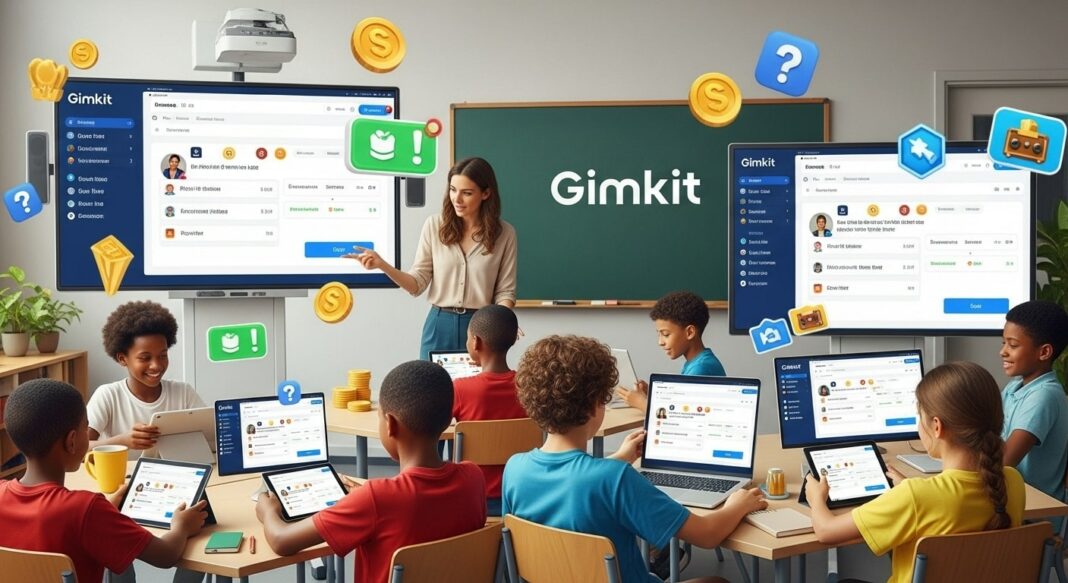Gimkit has been considered by a significant number of educators and students as an entertaining alternative to traditional quizzes throughout the course of the past several years. As a result of its combination of strategy, gamification and assessment, it is a very enticing option for contemporary educational institutions.
What is Gimkit?
Gimkit is a game-based learning tool that turns quizzes into fun, interactive experiences. Students don’t just answer questions; they also get virtual money for doing them right. You can spend that money to buy power-ups, upgrades, or other benefits in the game.
Educators make Kits, which are groups of questions that might be multiple choice or open-ended. Students can join and play live games or do homework at their own pace with a unique code. The software gives educators real-time feedback and post-game statistics so they can discover which questions or topics pupils had trouble with.
Gimkit is different from other games since it has gamified strategy elements. Players don’t just “answer and get points”; they also have to select when and how to spend their in-game money on things like multipliers, insurance, or other enhancements. That layer of decision-making makes Gimkit more interesting or “sticky” than other quiz sites.
Gimkit Login and Getting Started
In order to use Gimkit, you generally follow these steps:
- Visit the Gimkit website and sign up (or log in).
- From your dashboard, you can create or choose a Kit.
- To enter a game, students go to gimkit.com/join (or the equivalent join URL) and input the game code.
- Provide a name or nickname, then wait for the host to start the game.
Because the platform works across web and mobile, many users can join from laptops, tablets, or smartphones.
It’s worth noting that some limitations exist depending on your plan (free vs paid). For instance, free version users may have restrictions on how many Gamemodes they can access or how many students can join at once.
How to Change the Background in Gimkit Creative
Gimkit has a Creative mode (sometimes called Gimkit Creative) in which users can build maps, scenes, or platformer‑style experiences beyond simple quizzes. Within Creative, one common question is: how to change the background.
From community discussions and forum posts:
- In Map Options, there’s a “background” setting where you can pick a terrain (for example, “Dark Scraps”) instead of the default grass.
- Another approach is to use a Barrier device placed behind the player layer, with collision turned off, and tinted or colored to mimic a background. It might also require wiring a “zone enters” trigger to activate or deactivate that barrier.
- However, some users point out that currently there is no built-in dynamic background change mid‑map (for example, you can’t automatically swap backgrounds based on movement zones) – but colored barriers or props are a workaround.
So, in order to change the background in Gimkit Creative, you would open the map’s options, select a new terrain background, or use behind‑player layer devices (barriers, tinted props) to simulate desired backdrop changes.
Layers of the Atmosphere in Gimkit
Many educators use Gimkit to quiz scientific concepts, including the layers of the atmosphere. Here’s how one might set that up:
- Create a Kit (question set) themed around the atmospheric layers (troposphere, stratosphere, mesosphere, thermosphere, exosphere).
- In Creative mode, you could design a map where each region corresponds to a layer, and as players traverse zones, they answer questions relevant to that atmospheric layer (e.g. “Which layer contains the ozone layer?”).
- The visual background could shift from denser to sparser vegetation or from cloud visuals to space visuals (using background-changing techniques discussed above).
- Use triggers so that entering a “zone” prompts a quiz question or mini-challenge tied to that layer.
Because Gimkit supports props, zones, triggers and behind‑player layers, it’s quite flexible for turning an abstract concept like atmospheric layers into an interactive map.
Concerns about Gimkit Hacks
As with many online learning platforms, users sometimes search for Gimkit hacks – either out of curiosity, to gain an unfair advantage, or to alter how the game behaves. These so-called hacks may range from scripts that automate answers to tricks aimed at inflating in-game currency or disrupting sessions.
Some of these tools or hacks are talked about in small online communities, but it’s crucial in order to remember that employing them not only goes against the instructional objective of the site, but it might also break Gimkit’s Terms of Service.
Beyond the ethical implications, hacks can disrupt learning environments, frustrate educators, and skew assessment data. Most likely, those attempting to use such methods will end up harming the learning experience for themselves and others.
There may be Gimkit hacks out there, but using or sharing them is strongly prohibited. This is to keep things fair and to sustain the respectful, community-driven norms that Gimkit wants to maintain.
Gimkit Alternatives
It’s quite likely that someone reading this might wonder: If Gimkit doesn’t fully suit my needs, what other platforms should I consider? Below is a table and discussion of some popular alternatives.
| Platform | Strengths & Differentiators | Limitations / Differences vs Gimkit |
| Kahoot! | Strong live quiz experience, wide adoption | Less strategic depth (no in‑game currency mechanics) |
| Blooket | Variety of game modes, visually appealing | Free version analytics more limited |
| Quizizz | Self-paced quizzes, detailed analytics | Less “game adventure” flavor than Gimkit |
| Quizalize | Rich data tracking, mastery paths | Fewer game‑style mechanics than Gimkit |
| Factile | Jeopardy-style, buzzer mode | Doesn’t incorporate in‑game currency or power-ups |
| Nearpod | Full lessons + embedded quizzes | More comprehensive, but less “pure game” feel |
Concluding Thoughts
Gimkit is more than just a quiz tool – it is most likely one of the more engaging educational platforms because it combines conventional assessment with strategy and game mechanics. It gives educators real-time insight while keeping students excited. While the platform isn’t perfect (some users report glitches or connectivity issues), and there are always murmurings about hacks, Gimkit continues evolving (e.g., new props, terrain options, creative publishing tools) in response to feedback.
If your goal is to bring energy and interactivity into lessons, Gimkit can be a strong candidate. And if you ever feel that some things are missing (such as customizing the background or detailed statistics), there are good alternatives, like we talked about above.
Frequently Asked Questions (FAQs)
Q: What is Gimkit used for in the classroom?
A: Gimkit is mostly used for review sessions, formative assessment and reinforcing content in a fun way. Educators can gauge student understanding in real time.
Q: How many times can I use “Gimkit login” in one article?
A: That’s not a typical question in this context – but here in this article, we’ve included the phrase as part of the instructional flow.
Q: Is Gimkit free or paid?
A: Gimkit offers a free version with core features. Upgrading to a paid plan unlocks more game modes, analytics, and higher student capacity.
Q: Can I import quizzes from outside sources into Gimkit?
A: You can manually add questions or use the Kit library. Some users also import via spreadsheet or leverage Quizlet sets (depending on updates).
Q: What are layers of the atmosphere Gimkit quizzes?
A: That is just a thematic topic; you can build a quiz on those layers (troposphere, stratosphere, etc.) and perhaps integrate into Creative maps so players travel through zones representing each layer.
Q: Are there official Gimkit hacks supported by the platform?
A: No, official support and community guidelines discourage misuse, and hacking is typically third-party exploit attempts, which can violate rules.
Also Read: Err_Connection_Closed: What It Means and How to Fix It

I am a content writer with proven experience in crafting engaging, SEO-optimized content tailored to diverse audiences. Over the years, I’ve worked with School Dekho, various startup pages, and multiple USA-based clients, helping brands grow their online visibility through well-researched and impactful writing.


